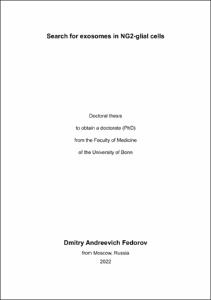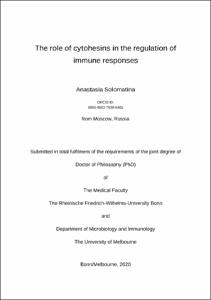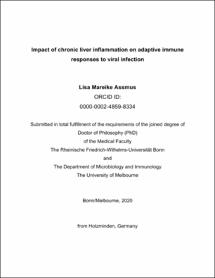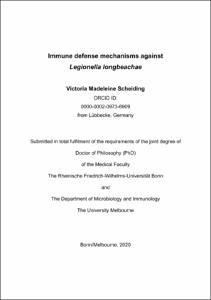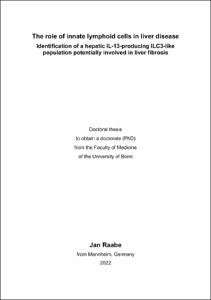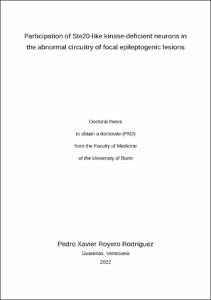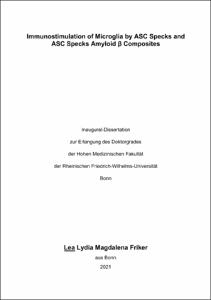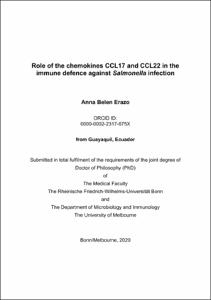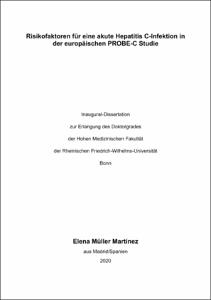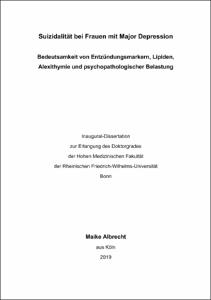E-Dissertationen: Search
Now showing items 11-20 of 35
Search for exosomes in NG2-glial cells
(2022-02-17)
NG2-glial cells is an abundant and widely distributed subtype of glia, featuring properties not typically associated with mature glial cells, such as the ability to receive synaptic input from neurons, or adult proliferation. ...
The role of cytohesins in the regulation of immune responses
(2020-02-17)
Cytohesins are guanine nucleotide exchange factors for adenosine diphosphate ribosylation factor (Arf) proteins and promote the switch of Arfs to the active GTP-bound form. Cytohesins have been shown in different in vitro ......
Impact of chronic liver inflammation on adaptive immune responses to viral infection
(2020-03-11)
A common complication in patients suffering from chronic liver inflammation and fibrosis is the enhanced susceptibility to viral infections and weak responses to vaccination, which are associated with significant co-morbidities. ...
Immune defense mechanisms against Legionella longbeachae
(2020-01-30)
The pulmonary epithelial barrier is the first line of defense against pathogens invading the lungs. If those are able to overcome this first barrier, myeloid cells of the innate immune system are instrumental for the ......
The role of innate lymphoid cells in liver disease: Identification of a hepatic IL-13-producing ILC3-like population potentially involved in liver fibrosis
(2022-05-23)
Innate lymphoid cells (ILCs) are a family of innate immune cells that mirror the functionality of T lymphocytes but do not express rearranged antigen receptors. As tissue-resident cells, ILCs primarily reside in peripheral ...
Participation of Ste20-like kinase-deficient neurons in the abnormal circuitry of focal epileptogenic lesions
(2022-01-03)
Focal epileptogenic lesions displaying morphologically altered neurons are frequently associated with devastating and therapy-refractory epilepsies. However, it is still unsolved how dysplastic neurons contribute to the ...
Immunostimulation of Microglia by ASC Specks and ASC Specks Amyloid β Composites
(2021-10-26)
Die Alzheimer-Krankheit stellt die weltweit häufigste Form der Demenz dar. Die genauen Mechanismen, welche zu ihrer Entstehung führen, sind bis heute nicht vollständig verstanden. Eine wichtige Rolle spielt die Aktivierung ......
Immunostimulation of Microglia by ASC Specks and ASC Specks Amyloid β Composites
Alzheimer’s Disease is the world’s most common cause of dementia. The exact mechanisms causing neurodegeneration ......
Immunostimulation of Microglia by ASC Specks and ASC Specks Amyloid β Composites
Alzheimer’s Disease is the world’s most common cause of dementia. The exact mechanisms causing neurodegeneration ......
Role of the chemokines CCL17 and CCL22 in the immune defence against Salmonella infection
(2020-03-17)
The chemokines CCL17 and CCL22 are both ligands of the chemokine receptor CCR4, which is expressed on dendritic cells (DC) and a variety of different effector T cells including regulatory T cells (Treg). Both chemokines ......
Risikofaktoren für eine akute Hepatitis C-Infektion in der europäischen PROBE-C Studie
(2020-10-14)
Ausbrüche von akuten HCV-Infektionen bei HIV-positiven MSM wurden seit 2000 berichtet. Diverse Studien haben die HCV-Infektion mit einer HIV-1-Co-Infektion assoziiert. Bisherige Forschung hat gezeigt, dass Übertragungs-Cluster ...
Suizidalität bei Frauen mit Major Depression: Bedeutsamkeit von Entzündungsmarkern, Lipiden, Alexithymie und psychopathologischer Belastung
(2019-05-21)
Vor dem Hintergrund neuerer Ansätze aus Biomarker-Forschung und Psychoneuroimmunologie zur Ätiologie der Suizidalität setzt sich die folgende Arbeit mit dem Einfluss von Entzündungsparametern, Lipiden sowie psychischer ...


